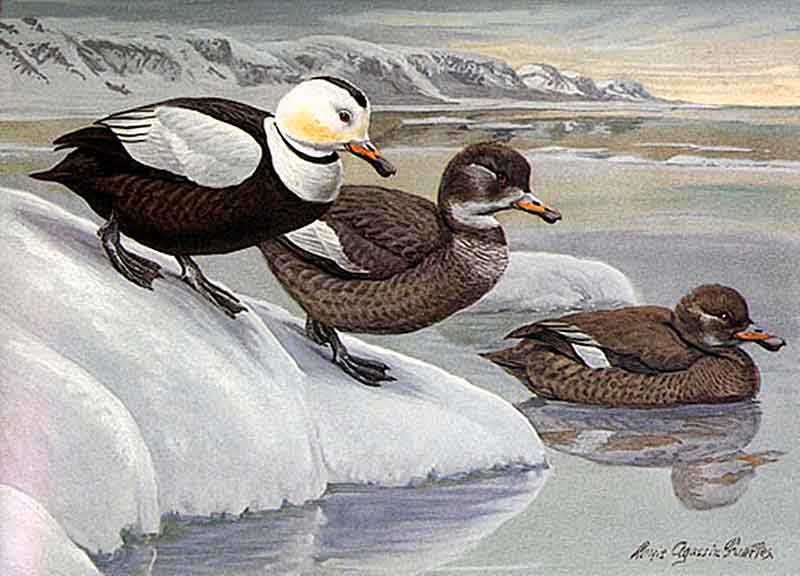Vintage illustrations of birds from around the world that are now extinct. Over 100 bird species have disappeared since the 1600s mainly due to human activities. There are numerous reasons for birds’ extinction including habitat loss, overhunting, and the introduction of non-native predators.
Flightless birds were particularly vulnerable to extinction as they were unable to escape from predators and as they were often endemic to remote islands had had little contact with other animal species so did not have an inbuilt fear. Once their homes were colonised by humans their curiosity got the better of them and they were either hunted to extinction or killed off by introduced predators.

01
Canarian Oystercatcher
Haematopus meadewaldoi
Also known as the Canary Islands oystercatcher the Canarian oystercatcher was a shoveler endemic to Fuerteventura andLanzarote. It was considered a subspecies of the African oystercatcher until DNA analysis in 2018 concluded that it was more likely to be a subspecies of the Eurasian oystercatcher. It was last collected in 2913 and has been considered extinct since the 1980s.

02
Labrador Duck
Camptorhynchus labradorius
The Labrador duck was a North American duck that became extinct after the Columbian Exchange, the transfer of human populations, plants, animals, culture, technology, and diseases between the Americas, West Africa, and the Old World. Its last known sighting was in New York in 1878.

03
Javan Lapwing
Vanellus macropterus
Also known as the Javanese wattled lapwing the Javan lapwing was last seen in 1940. Surveys carried out in 2001 and 2002 could not locate any birds but interviews with local people produced evidence that the species could still be present.

04
Cuban Macaw
Ara tricolor
The Cuban macaw was endemic to the main island of Cuba and the nearby Isla de la Juventud. It was traded and hunted by Native Americans and Europeans and many birds were brought to Europe as caged birds. It was reportedly stupid and slow to escape and was hunted to extinction in the late 19th century.

05
Eskimo Curlew
Numenius borealis
The Eskimo curlew or northern curlew was one of the most numerous shorebirds in the tundra of western Arctic Canada and Alaska with a population in the millions. There has not been a reliable sighting since 1987 and it is now presumed extinct although this has not been confirmed as not all possible remaining habitats have been surveyed.

06
Passenger Pigeon
Ectopistes migratorius
The passenger pigeon was endemic to North America. It was hunted for food and he last wild bird was shot in 1901. A number of captive passenger pigeons remained until the turn of the 20th century until the death of Martha, thought to be the last passenger pigeon, in September 1914.

07
Kangaroo Island Emu
Dromaius novaehollandiae baudinianus
The Kangaroo Island emu or dwarf emu was restricted to Kangaroo Island, Australia and was much smaller in size than the mainland emu. It became extinct in about 1827 due to hunting and habitat loss from burning.

08
Great Auk
Pinguinus impennis
The great auk was a species of flightless bird that became extinct in the mid-19th century. The bird’s down was popular in Europe and as it became rarer its eggs became prized by collectors. The last two specimens were killed off the coast of Iceland in 1844.

09
New Zealand Quail
Coturnix novaezelandiae
The New Zealand quail has been extinct since 1875. It was first described by Sir Joseph Banks when he visited New Zealand on James Cook’s first voyage. In 2007 investigations were conducted to find out whether the quails on Tiritiri Matangi Island may be a surviving population of the species but a genetic study found that they were Australian brown quail.

10
Hawaii Mamo
Drepanis pacifica
The Hawaii mamo was a species of honeycreeper, endemic to Hawaii, that become extinct in about 1899. It was one of the most honoured bird in pre-European Hawaiian society with its yellow feathers used for hats and capes for royalty.

11
Spectacled Cormorant
Phalacrocorax perspicillatus
The spectacled cormorant or Pallas’s cormorant was a marine bird that inhabited Bering Island until it went extinct in the 1850s. Little is known about the species although it was described by Georg Steller in 1741 as large, clumsy, and almost flightless. Cormorants usually taste bad when eaten but Steller said the spectacled cormorant was delicious particularly when encased in clay and baked in a heated pot.

12
Pink-Headed Duck
Rhodonessa caryophyllacea
The pink-headed duck was a large diving duck found in parts of India, Bangladesh, and Myanmar. It has been feared extinct since the 1950s. It was always a rare bird , sought after by hunters because of its unusual appearance, but habit destruction led to its final disappearance